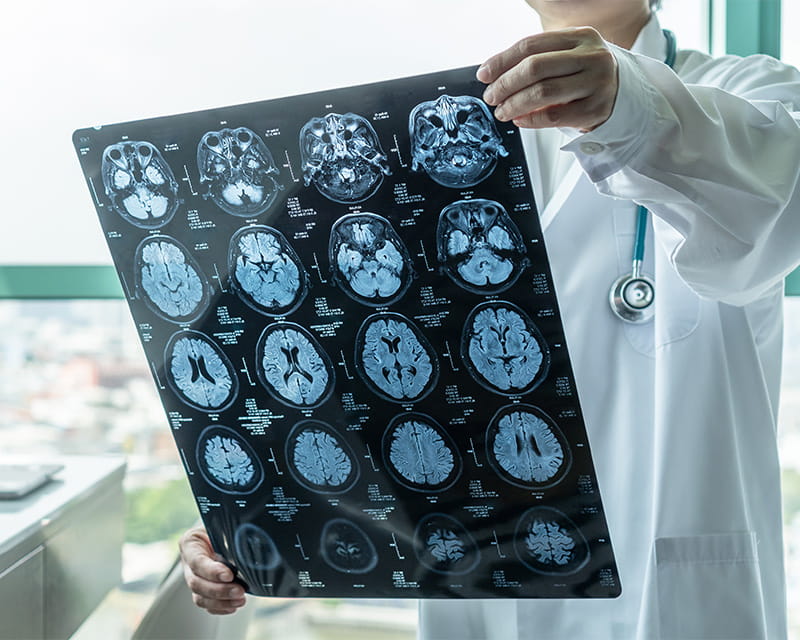
Novel research explores neurobiological mechanisms driving sarcopenia in aging
 Deep brain stimulation (DBS), which sends electrical stimulation to targeted areas of the brain, isn’t a new technique. But neurosurgeons at The Ohio State University Wexner Medical Center are taking it to the next level.
Deep brain stimulation (DBS), which sends electrical stimulation to targeted areas of the brain, isn’t a new technique. But neurosurgeons at The Ohio State University Wexner Medical Center are taking it to the next level.
Brian Dalm, MD, neurosurgeon in the Ohio State Wexner Medical Center Department of Neurological Surgery, says advancements in imaging and the use of robotics are making DBS safer and more precise.
“Pushing the boundaries and innovating around DBS allows us to provide more individualized treatments,” Dr. Dalm says. “The imaging work and robotics we’re using removes guesswork and allows our team to cater more specifically to each patient, rather than to general anatomical structures.”
DBS was first approved over two decades ago as a treatment to control essential tremor and Parkinson’s disease symptoms. With time on their side, Dr. Dalm says, neurosurgeons now have a much better understanding of the connectivity and function of the areas of the brain targeted by this treatment. And getting a better look at these areas is making it easier to place leads during DBS surgery, which ultimately improves outcomes.
“There are DBS studies that suggest certain side effects are related to the number of passes it takes to place a lead,” Dr. Dalm says. He emphasizes that better preoperative and intraoperative visualization of the brain is allowing for more individualized treatments, while also reducing the need for lead placement adjustments.
“The major advancements we’ve seen and have put to use here at the Ohio State Wexner Medical Center are focused on functional connectivity and tractography,” Dr. Dalm says. “Imaging studies have helped us identify and better predict where the lead should be. We’ve been able to parcellate out the different aspects of the globus pallidus or the subthalamic nucleus — areas we target to treat Parkinson’s disease.”
For example, Dr. Dalm and his team are using magnetic resonance imaging (MRI) combined with tractography, a 3D modeling technique. For Parkinson’s-related DBS procedures involving the globus pallidus, this advanced imaging technique enables Dr. Dalm to see each portion of the globus pallidus and then directly target the area responsible for motor control.
The team also uses MRI tractography for essential tremor in order to view and target the ventral intermediate nucleus (VIM) of the thalamus.
“The VIM has traditionally been one of the more difficult targets to identify with imaging,” Dr. Dalm says. “We use tractography to define the specific borders of the VIM, but we don’t just use that as a coordinate. We then create a cylinder in the thalamus, where the VIM is, which we then burn into the imaging used for the procedure. This helps us predict the volume of activation when we place the lead so that we can avoid stimulating nearby structures that we don’t want to stimulate.”
The team is also using robotics for DBS lead placement. This, Dr. Dalm says, removes the potential for human error that comes with manually dialing in coordinates using traditional stereotactic equipment.
These imaging techniques have allowed Dalm and his team to confidently insert DBS leads with such a high rate of precision that we are increasingly offering asleep DBS to those individuals who may prefer to not be awake during surgery.
DBS techniques for Parkinson’s disease and essential tremor, perfected at the Ohio State Wexner Medical Center, are shared with neurosurgeons who are now using DBS as a treatment for epilepsy.
This information-sharing happens through the medical center’s Center for Neuromodulation. The center’s team meets to discuss each patient and all treatment options—down to the specific DBS device that may be best for their individual situation.
Patients with epilepsy benefit from this multidisciplinary approach to care. Though not as common as vagus nerve stimulation or responsive neurostimulation for the treatment of epilepsy, DBS is becoming more widely used to reduce seizure rates.
“When it comes to DBS, there are several ways to approach it,” Dr. Dalm says. “Fortunately, here at the Ohio State Wexner Medical Center, we offer all approaches.”
The Ohio State Wexner Medical Center’s Center for Neuromodulation is a one-stop clinic for people in need of both neurological and neurosurgical care.